Mattapoisett River Valley Water Withdrawals
Background
The Mattapoisett River watershed and Harbor, located in southeastern Massachusetts along the shores of Buzzards Bay, covers 18,000 acres, or more than 28 square miles. The river stretches approximately 10 miles from its headwaters at the 710-acre Snipatuit Pond to Mattapoisett Harbor, its receiving waters. The watershed includes large portions of the Towns of Mattapoisett, Acushnet, Fairhaven, and Rochester, and its groundwater aquifer provides drinking water for tens of thousands of residents through public and private wells, in the Towns of Marion and Fairhaven.
This watershed includes environmentally valuable forested wetlands and uplands, and is habitat to numerous species including some that are rare or endangered. The majority of the watershed and parts of the river have been identified by the state as containing core habitats, defined as the most viable habitat for rare plant and animal species and natural communities (see attached Map 3). Mattapoisett Harbor has productive shellfish beds and popular swimming beaches. The river has one of the most important herring runs in the region. Snipatuit Pond is the principal habitat for juvenile herring, and these herring are an important food source for many species in the coastal waters of Buzzards Bay, including roseate terns, a US endangered species with 50% of the North American breeding population nesting within a few miles of Mattapoisett Harbor.
This river basin has eight public water supply wells and countless private wells serving the needs of five municipalities (map at right). Future uncontrolled water withdrawals are likely to alter the river’s flow during dry periods. The Massachusetts Department of Fish and Game Riverways Program’s “Low Flow Inventory” website (2005) had previously noted that the Mattapoisett River has already experienced low flow problems. In 2004 they wrote “In September of 1999, a freshwater mussel surveyor … found a series of deep pools with little flow between them on the Mattapoisett River at the Route 6 crossing in Mattapoisett. Further upstream just north of Route 195 in Mattapoisett [in the vicinity of public wells], the river was “bone dry” and local kids were riding their ATV’s up and down the stream banks.” In 2007, the river again was documented as having run dry (see photo and graph below). Prior to 1999, there were no reports of the river running dry.
| PWS ID | PWS Name | Town/City | Accepted RGPCD | Accepted UAW (%) |
| 4094000 | Fairhaven water department | Fairhaven | 58.3 | 5.6 |
| 4169000 | Marion water department | Marion | 59.9 | 10 |
| 4173000 | Mattapoisett water & sewer dept | Mattapoisett | 47.8 | 7.9 |
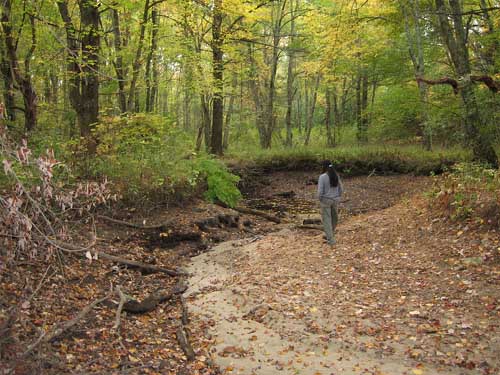
In October 2007, more than a thousand feet of the Mattapoisett River ran dry. This photo, in the vicinity of municipal wells, occurred during drought conditions, when water diversions were also occurring in cranberry bogs at the head of the river. Photo courtesy of Massachusetts DEP Riverways program.
To protect water quality and wetland habitat in this watershed it is clear that efforts are needed to better manage future public and private water use. The municipalities that share the water resources of this valley will need to develop and implement a water use management plan for the watershed, with a strong focus on water conservation measures. Supporting actions could include increased stormwater recharge to groundwater, and efforts to promote Low Impact Development strategies and increased stormwater infiltration for new development and redevelopment.
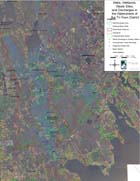
Mattapoisett River wells and recharge areas. Click map to enlarge.
Water Withdrawals and “Sustainable Yield”
A 1980 Metcalf and Eddy Engineering report to the Town of Marion estimated that the “safe yield” of the Mattapoisett River basin was 9.8 MGD. However, this report adopted a definition of safe yield where the value would result in less recharge than withdrawals on average of 7 out of 10 years (i.e. the river would go dry 3 out of ten years). The report also acknowledged many uncertainties in their analysis.
A USGS study (Olympio and De Lima, 1984) concluded that an estimated 78% percent of the Mattapoisett River basin well water is transferred and discharged outside of the river subbasin where it serves populations in Marion and Fairhaven. They predicted that the river could run dry during 1965-type drought conditions if peak month water withdrawals exceeded 4 million gallons per day. A 1995 EOEA report concluded that the Mattapoisett River water supply had “little available yield”, and that the river was already “somewhat stressed” due to the fact that an average 2.31 MGD is transferred outside the watershed. In 1995, another USGS study (Bent, 1995) had a similar conclusion. This report estimated that 87% of the ground water withdrawn from the Mattapoisett River subbasin was not returned to the subbasin. The USGS Buzzards Bay drainage basin website notes “The Mattapoisett River valley can probably yield about 4 Mgal/d without causing the river to be dry during low-flow periods in years of average precipitation.” The actual maximum permitted withdrawals of all wells in the Mattapoisett River now stands at 5.985 MGD.
Data on River Flow and Water Withdrawals
The USGS has made intermittent measurements of stream flow along various portions of the Mattapoisett River, particularly in the years 1965, 1972-74, 1982, 1991-92, and 2006-2009 (see this USGS 2008 data report). USGS does not have real-time data gauge for this site.
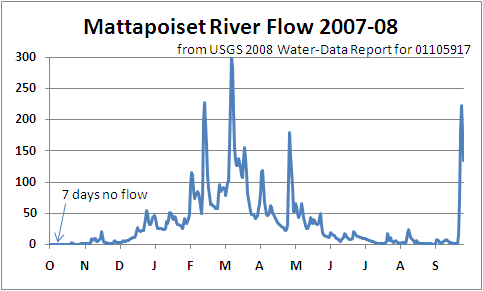
Graphic prepared from 2007 to 2008 data for Mattapoisett River Flow reported by the USGS.
Municipalities must report water withdrawals to the Massachusetts DEP (ASR data), and water use data can also obtained by reviewing town annual reports. Below is the annual water use summary, standardized as MGD. Water withdrawal data for 1977 to 1981 are taken from Olympio and De Lima (1984), 1992 data from Bent (1995), and 1992 to the present was taken from town reports and summaries from the Mattapoisett Water Department (courtesy Nick Nicholson). The 1992 data onward is adjusted for water withdrawals by the town of Marion for a well which is outside the Mattapoisett River valley, so the annual average MGD is for valley basin only withdrawals.
Average annual water withdrawals do not tell the whole story, and a better picture emerges of stream flow when peak water demand is compared to rainfall. Peak water demand for the 1997 to 2003 figure was based on actually daily summaries for that period calculated by Nick Nicholson. These totals are adjusted The monthly max totals were taken from town or ASR reports, and combined, even though the month of the maximum are not coincident. This is thus an imperfect approximation of maximum river demand, and a more comprehensive evaluation of all municipal water withdrawals is needed. The data, however, strongly indicate that summer rains of less than 11″ (June through September) appear to cause the river to run dry, given the high water use in the watershed (figure below). Neither annual rainfall, nor water year (October through September coinciding wet dry cycle) are as good as summer rainfall in predicting cessation of river flow (not shown).
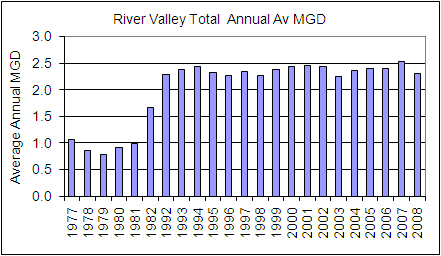
Combined annual water withdrawals (adjusted to MGD) for the towns of Fairhaven, Marion, and Mattapoisett, adjusted for Marion withdrawals outside of the river valley
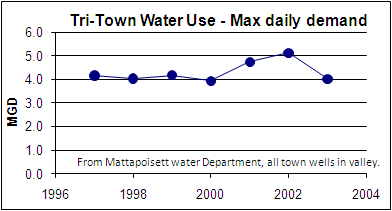
Peak daily demand for the Towns of Fairhaven, Marion, and Mattapoisett, in the river valley (data courtesy of Nick Nicholson).
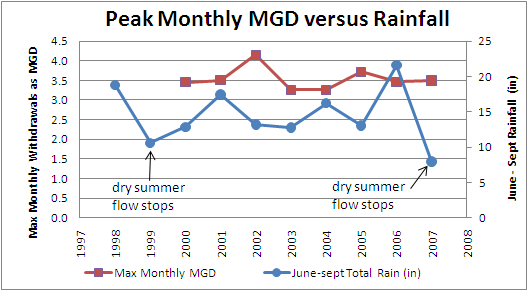
Peak monthly demand for the Towns of Fairhaven, Marion, and Mattapoisett. Peak months may not be coincident, and total values are meant show approximate peak demand.
Additional Information and References Cited
BBNEP. 2005. Targeted Watershed Action Plan for the Mattapoisett River. This watershed proposal, to better manage water withdrawals to the Mattapoisett River, and conserve municipal water use, was not funded.
USGS. 2008. Water-Data Report 2008 01105917 Mattapoisett River near Mattapoisett, ma
Note: 1 cfs=646272 gpd.